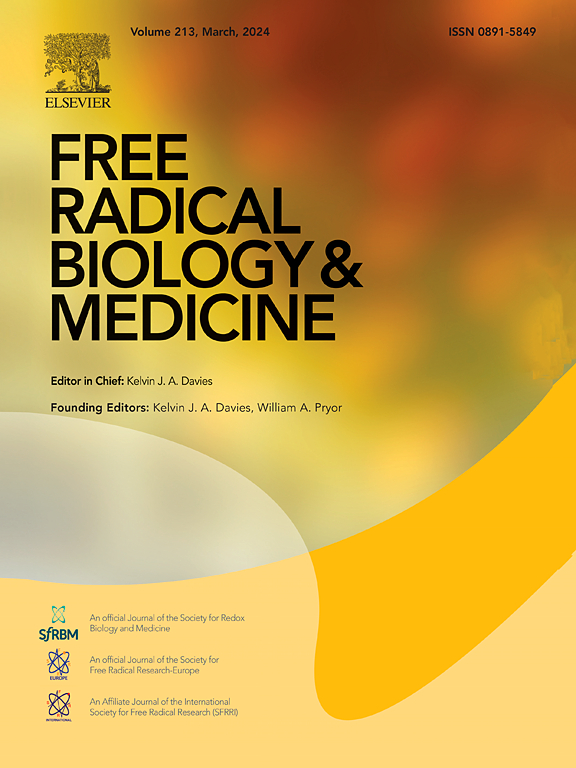Secoiridoid-enriched extra virgin olive oil extracts enhance mitochondrial activity and antioxidant response in colorectal cancer cells: The role of Oleacein and Oleocanthal in PPARγ interaction
IF 7.1
2区 生物学
Q1 BIOCHEMISTRY & MOLECULAR BIOLOGY
引用次数: 0
Abstract
The secoiridoid-enriched fraction of extra virgin olive oil (EVOO) provides significant health benefits, but its underlying mechanisms have not been fully elucidated. To investigate this, we analyzed the transcriptome of HCT116 colorectal cancer cells treated with secoiridoid-enriched EVOO extracts using bioinformatic tools and identified differentially expressed genes enriched in mitochondrial pathways. In vitro validation showed increased mitochondrial mass and DNA driven by enhanced biogenesis and fusion events, accompanied by higher mitochondrial respiration and ATP production. The resulting increase in reactive oxygen species (ROS) triggered a cellular response involving AMPK, NRF2, and antioxidant genes, along with PGC-1α, a master regulator of mitochondrial metabolism. To correlate the biological effects with the components of the secoiridoid-enriched EVOO extracts, we focused on Oleacein (OL) and Oleocanthal (OC). Molecular docking and dynamics simulations predicted both compounds bind to peroxisome proliferator-activated receptor gamma (PPARγ) as partial agonists, with OL exhibiting stronger affinity. Treatments with isolated OL and OC mostly replicated the results of the whole extracts. Mechanistically, we provided evidence of the crucial role played by PPARγ as the effects on the pathways analyzed were reduced by either blocking the receptor with an irreversible inhibitor and silencing the PPARG gene with specific siRNAs.
This study reveals the AMPK-PGC-1α-PPARγ axis as a key regulator of OL and OC's effects on mitochondrial function and antioxidant response, supporting their potential as nutraceuticals for health promotion and opening avenues for developing novel PPARγ modulators to complement existing therapeutic strategies.

富含secoiridoid的特级初榨橄榄油提取物增强结直肠癌细胞的线粒体活性和抗氧化反应:油酸苷和油酸在PPARγ相互作用中的作用
特级初榨橄榄油(EVOO)富含二环烯醚萜的部分提供了显著的健康益处,但其潜在的机制尚未完全阐明。为了研究这一点,我们使用生物信息学工具分析了经富含赛环烯醚酮的EVOO提取物处理的HCT116结直肠癌细胞的转录组,并鉴定了线粒体途径中富集的差异表达基因。体外验证显示,由于生物发生和融合事件的增强,线粒体质量和DNA增加,同时线粒体呼吸和ATP产生增加。由此产生的活性氧(ROS)的增加引发了涉及AMPK、NRF2、抗氧化基因以及线粒体代谢的主要调节因子PGC-1α的细胞反应。为了将生物效应与富含二环烯醚酮的EVOO提取物的成分联系起来,我们重点研究了油酸苷(OL)和油酸苷(OC)。分子对接和动力学模拟预测,这两种化合物作为部分激动剂与过氧化物酶体增殖体激活受体γ (PPARγ)结合,其中OL表现出更强的亲和力。分离油和OC处理的结果与全提取物的结果基本一致。在机制上,我们提供了PPARγ发挥关键作用的证据,因为用不可逆抑制剂阻断受体和用特定sirna沉默PPARG基因可以减少对所分析途径的影响。本研究揭示了AMPK-PGC-1α-PPARγ轴是OL和OC对线粒体功能和抗氧化反应影响的关键调节因子,支持它们作为健康促进营养药品的潜力,并为开发新的PPARγ调节剂来补充现有的治疗策略开辟了道路。
本文章由计算机程序翻译,如有差异,请以英文原文为准。
求助全文
约1分钟内获得全文
求助全文
来源期刊

Free Radical Biology and Medicine
医学-内分泌学与代谢
CiteScore
14.00
自引率
4.10%
发文量
850
审稿时长
22 days
期刊介绍:
Free Radical Biology and Medicine is a leading journal in the field of redox biology, which is the study of the role of reactive oxygen species (ROS) and other oxidizing agents in biological systems. The journal serves as a premier forum for publishing innovative and groundbreaking research that explores the redox biology of health and disease, covering a wide range of topics and disciplines. Free Radical Biology and Medicine also commissions Special Issues that highlight recent advances in both basic and clinical research, with a particular emphasis on the mechanisms underlying altered metabolism and redox signaling. These Special Issues aim to provide a focused platform for the latest research in the field, fostering collaboration and knowledge exchange among researchers and clinicians.
 求助内容:
求助内容: 应助结果提醒方式:
应助结果提醒方式:


